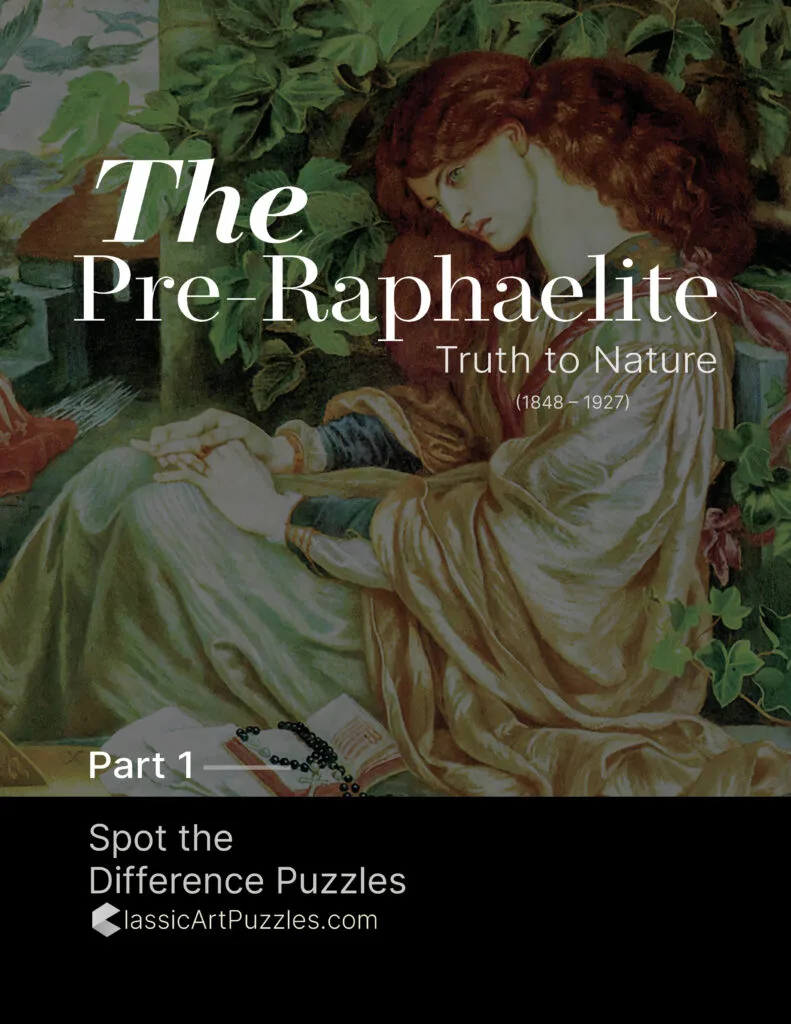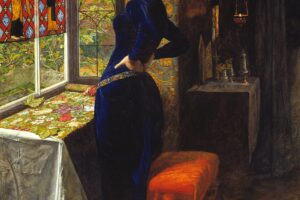Table of Contents
Overview
The Mirror of Venus (1866–1877) by Edward Burne-Jones is one of the most celebrated images of the Aesthetic and Pre-Raphaelite movements. It depicts ten maidens gathered around a still pool in a barren landscape, their faces reflected on the water’s surface. At the center stands Venus, goddess of beauty, serene and commanding, as the others kneel to gaze upon their mirrored images.
Burne-Jones (1833–1898) was a leading figure of the later Pre-Raphaelites, known for his dreamlike symbolism and refined elegance. In this work, he blends myth, allegory, and decorative harmony, transforming a simple reflection into a meditation on beauty, vanity, and spiritual longing.
First exhibited in the 1870s, the painting captivated Victorian audiences with its haunting atmosphere and poetic restraint. Today, it remains a defining example of Burne-Jones’s style: a world where classical mythology, romantic melancholy, and Pre-Raphaelite detail converge in timeless vision.
About the Artist

Edward Burne-Jones (1833–1898) was a British painter and designer associated with the second wave of the Pre-Raphaelite Brotherhood. Deeply influenced by Italian Renaissance art and medieval romance, his works are marked by ethereal figures, mythological allegories, and jewel-like color. A close collaborator of William Morris, Burne-Jones also shaped the decorative arts through stained glass, tapestries, and book design, leaving a lasting legacy on both fine art and design.
The Story Behind the Painting
Mythological Inspiration
The subject draws upon Venus, the Roman goddess of beauty and love. Unlike traditional depictions of Venus as sensual or triumphant, Burne-Jones places her in a barren, rocky landscape, a symbol of timeless solitude. The maidens who surround her represent humanity’s longing for beauty and reflection, gazing at their own mirrored images as if seeking meaning in their likeness.
A Victorian Allegory
To Victorian audiences, the work resonated as a meditation on vanity, mortality, and the fleeting nature of beauty. The stillness of the water suggests fragility: one ripple could erase the reflection, reminding viewers that beauty is transient.
Burne-Jones’s Spiritual Vision
For Burne-Jones, myth and allegory were not entertainment but spiritual parables. The Mirror of Venus was less about physical vanity than about humanity’s eternal quest for harmony and self-understanding.
Composition and Subjects
Venus at the Center
Venus, robed in deep blue, stands tall and serene. Her posture is upright, her gaze distant, embodying timeless beauty. She does not bend to see her reflection; she needs no confirmation of her divinity.
The Maidens and Reflection
Nine maidens kneel around the pool, leaning forward to glimpse their faces in the mirrored water. Their varied poses — contemplative, yearning, tender — create a rhythm of motion, their reflections doubling their presence. The act of gazing suggests both vanity and vulnerability, an allegory of human fragility.
The Landscape
The barren mountains and sparse trees frame the scene with solemn stillness. The stark setting contrasts with the maidens’ rich robes, symbolizing beauty’s endurance even amid desolation.
Decorative Harmony
The composition is frieze-like, the figures arranged in graceful order. The repetition of color — crimson, violet, blue — and the soft modeling of form create a tapestry-like surface, uniting myth with ornament.
Art Style and Techniques
Aesthetic Movement Elegance
Painted between 1866 and 1877, the work reflects the ideals of the Aesthetic Movement — art for beauty’s sake. Burne-Jones sought harmony of line, color, and mood rather than literal storytelling.
Jewel-like Palette
The robes shimmer in deep crimson, indigo, and emerald tones, contrasting against the earthy landscape. The reflective water doubles the intensity, as if the colors themselves mirror eternity.
Symbolist Undertones
Though painted in Pre-Raphaelite clarity, the work leans toward Symbolism. The reflections, barren land, and solemn mood suggest deeper themes of mortality, longing, and the soul’s search for meaning.
Legacy and Reflection
Reception in the 19th Century
Victorian viewers were fascinated by the painting’s combination of beauty and restraint. Unlike Rossetti’s sensual women or Millais’s dramatic narratives, Burne-Jones offered an allegory that was haunting, solemn, and poetic.
Lasting Significance
Today, The Mirror of Venus is regarded as one of Burne-Jones’s masterpieces. It embodies the transition from Pre-Raphaelite intensity to Aesthetic elegance, while foreshadowing the Symbolist movement in European art.
Featured in Our Collection
The Mirror of Venus is proudly featured in our Pre-Raphaelite Spot-the-Difference Puzzle Flipbook. The painting’s mirrored reflections and jewel-like colors make it a perfect puzzle subject, inviting you to explore subtle differences in detail while immersing yourself in Burne-Jones’s vision of timeless beauty. Through interactive play, you can sharpen observation and deepen appreciation for one of the era’s most iconic works.
The Stillness of Beauty
The maidens kneel, Venus stands apart, and the still pool gathers every gaze. In The Mirror of Venus, Burne-Jones transforms reflection into allegory — a meditation on beauty, fragility, and the eternal mirror of the soul.




